Nutrition of guinea pigs
A suitable feed for guinea pigs should consist of 70-80% hay, 10-20% fresh feed and approximately 10% dry pellets or pellets.
Guinea pigs, like rabbits, are true herbivores. Guinea pigs develop food preferences at an early age and do not easily adapt to changes in food types, appearance or presentation. Sudden changes may lead to food refusal. Any adjustments to a guinea pig's diet should therefore be made gradually. If a guinea pig is fed inappropriate food, this can bring a variety of health problems.
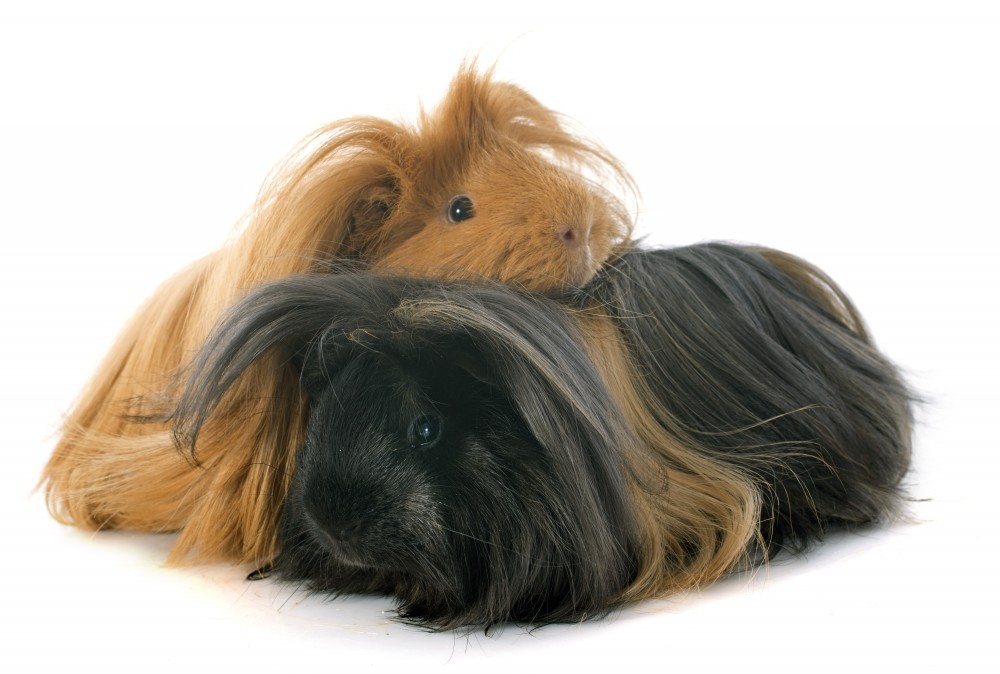
The following guinea pig foods are listed in order of importance:
1. Hay - low in calories, high in fiber.
2. Water
3. Fresh feed - medium calorie, medium fiber content.
4. Dry feed (pellets/pellets) - high calorie, low fiber.
5. Vitamin C - need daily.
Ratio of individual ingredients in guinea pig feed
An adult guinea pig weighing 1 kg ingests 70 grams of food per day. Its ideal composition should be as follows:
|
Type of food |
Share of total quantity |
Physical volume |
|
Hay |
70-80 % |
49-56 g |
|
Fresh feed |
10-20 % |
7-14 g |
|
Commercial dry feed/pellets, pellets |
10 % |
7 g |
Hay
Hay is a major component of the diet and should be available to guinea pigs at all times. The fibre in hay is extremely important in supporting normal gut function. It also contains essential proteins and nutrients.
Guinea pigs take smaller amounts of feed several times throughout the day and high quality hay must be available in unlimited quantities throughout the day. Avoid alfalfa hay as this contains a high calcium content.
In general, hay sold in bales for feeding horses is often of better quality than the smaller vacuum-packed hay available in pet stores. Long straw bales are preferable because guinea pigs spend more time chewing the long straws, which benefits their teeth and digestion. If you buy large quantities of hay, store it so that it does not become wet or mouldy; do not store hay in plastic bags.
The best way is to feed the guinea pigs fresh hay using a 'ladder feeder'. The feeder keeps the hay clean and prevents it from being trampled and soiled by faeces. As a rule, a small amount of hay should be left in the feeder in the morning after each night. That way we know immediately that we have given the guinea pig a sufficient amount.
Frozen dry grass for guinea pigs is also commonly sold. This can be fed at the same time as good quality hay in unlimited quantities.
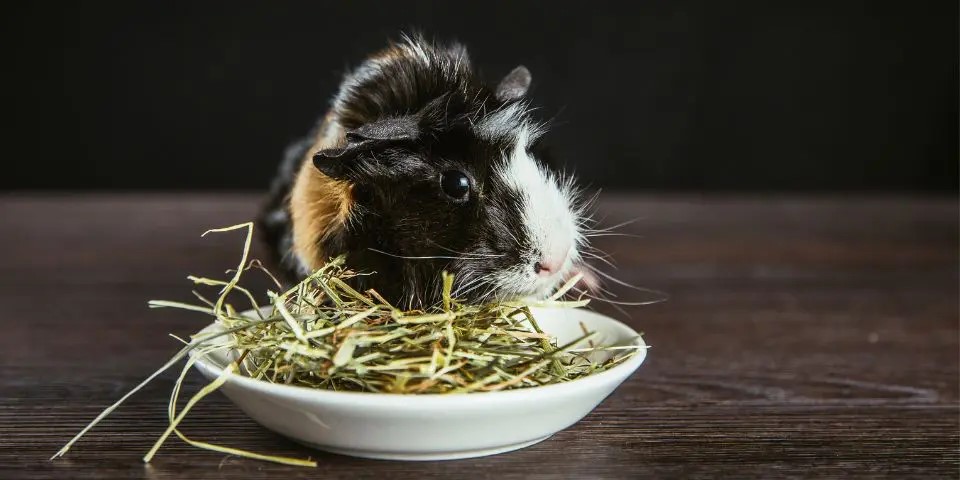
Water for guinea pigs
Fresh water should always be available. Water should be in a supply bottle with a dropper. Do not use water bowls as the guinea pig will soon contaminate them with its droppings. The dropper bottle must be cleaned regularly. Also check regularly that it is not dripping water. In winter, you can add a few drops of glycerine to the bottle to prevent the water from freezing (available at the pharmacy).
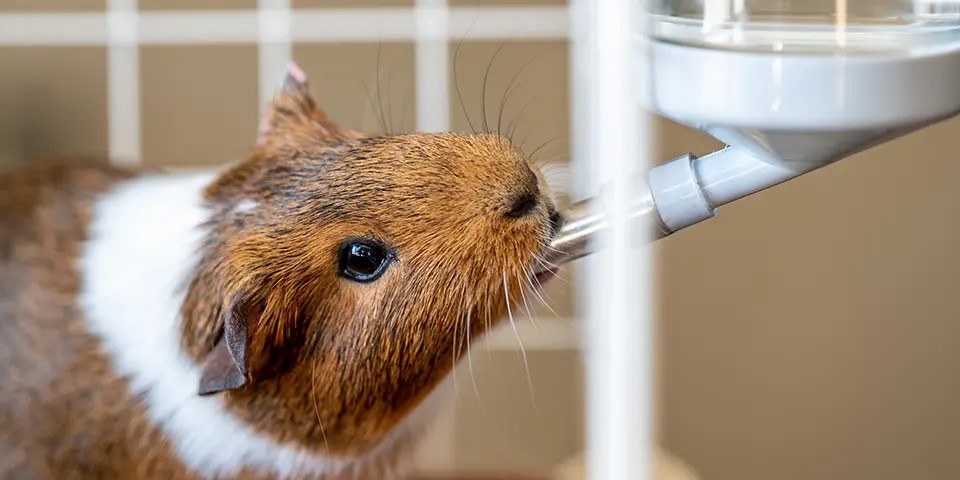
Fresh feeding
Fresh food should be given to guinea pigs daily. Hay can lose some of its vitamins during the drying process, so it is important to enrich your guinea pig's diet with fresh greens.
Examples of fresh food for guinea pigs:
|
Meadow plants |
Flowers/leaves |
Leafy greenery |
Watery feeding |
Herbs |
|
Grass |
Raspberry leaves |
Rukola |
Maize |
Basil |
|
Dandelion |
Rose leaves |
Spinach |
Green pepper |
Dill |
|
Marigold |
Rose Petals |
Brussels sprout |
Red pepper |
Fennel |
|
Milk |
Watercresses |
Brassica green |
Celery |
Mint |
|
|
Flour tops |
Broccoli |
Cress |
Parsley |
|
|
|
Cabbage (dark green not white) |
|
Coriander |
|
|
|
Check |
|
|
Fresh fruit can only be fed in small amounts due to its high carbohydrate content. Too much fruit can lead to dental disease and obesity in guinea pigs.
Watch out for fresh feed with high calcium content
Similar to rabbits, guinea pigs absorb calcium through the intestine and excrete excess calcium in the urine. If guinea pigs ingest a large volume of food with a high calcium content (e.g. alfalfa, dandelion, kale, parsley or spinach), their urine is chalky and calcium crystals form. They may then develop diseases from excess calcium in the urine - urolithiasis (urinary calculi) and/or cystitis (inflammation of the bladder).
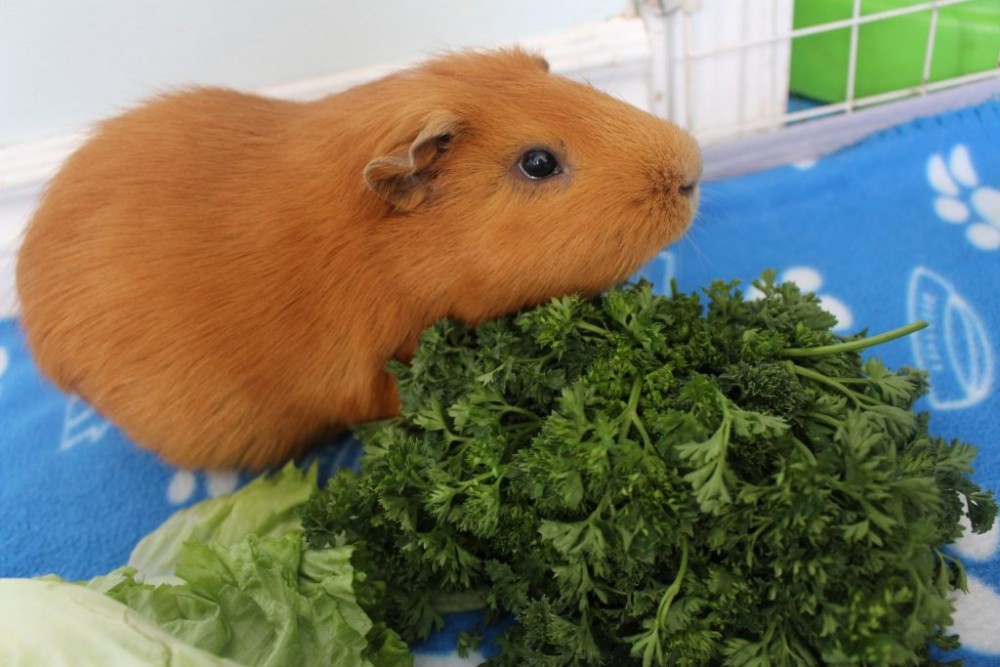
Dry feeding
A small amount of dry food can be fed every day. Especially compressed nutritionally balanced pellets. Quality pellets contain all the necessary nutrients
Many owners feed guinea pigs commercial dry food twice a day (breakfast and dinner). The guinea pigs like it as they find it very attractive and tasty. However, it is very important not to give guinea pigs too much dry food (see table above) as they will not consume enough hay. The aim is to keep the adult animals at a constant live weight, as a normal weight is essential for the guinea pig. Overfeeding dry pelleted feed is a major cause of health problems.
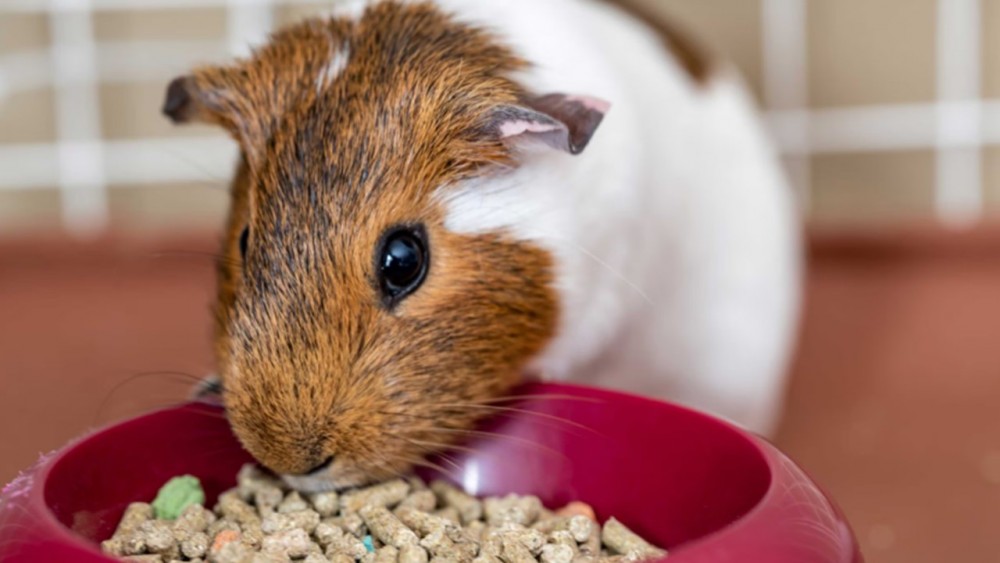
Why is the high ratio of concentrated dry feed such a problem?
If guinea pigs take large amounts of dry concentrated food (pellets, pellets) they chew less, which leads to the development of dental disease. When a guinea pig does not have to chew concentrated dry food as much, it will eat it quickly and in larger quantities. This food swells in the stomach, which can lead to stomach problems.
By feeding large amounts of dry concentrated food, the guinea pig also gains weight. Subsequent overweight and obesity then leads to the development of fatty degeneration of the liver, pododermatitis and worsening of arthritis symptoms.
Last but not least, by feeding large amounts of dry concentrated feed, the guinea pig is less interested in hay, which is essential for preventing intestinal disease due to reduced intestinal peristalsis.
Beware of commercial muesli diets for guinea pigs
Expert studies conducted in rabbits have shown a direct link between feeding muesli diets and the development of dental disease. Since rabbits and porcupine-like rodents (e.g. guinea pig, chinchilla, octopus) have similar dentition, it is reasonable to assume that dental disease is also associated with the feeding of muesli diets in guinea pigs. For this reason, we should not offer guinea pigs any muesli diets at all. If this is already the case, we recommend that all home-reared guinea pigs are weaned off muesli diets and switched to complete and more suitable pelleted diets in the correct amounts.
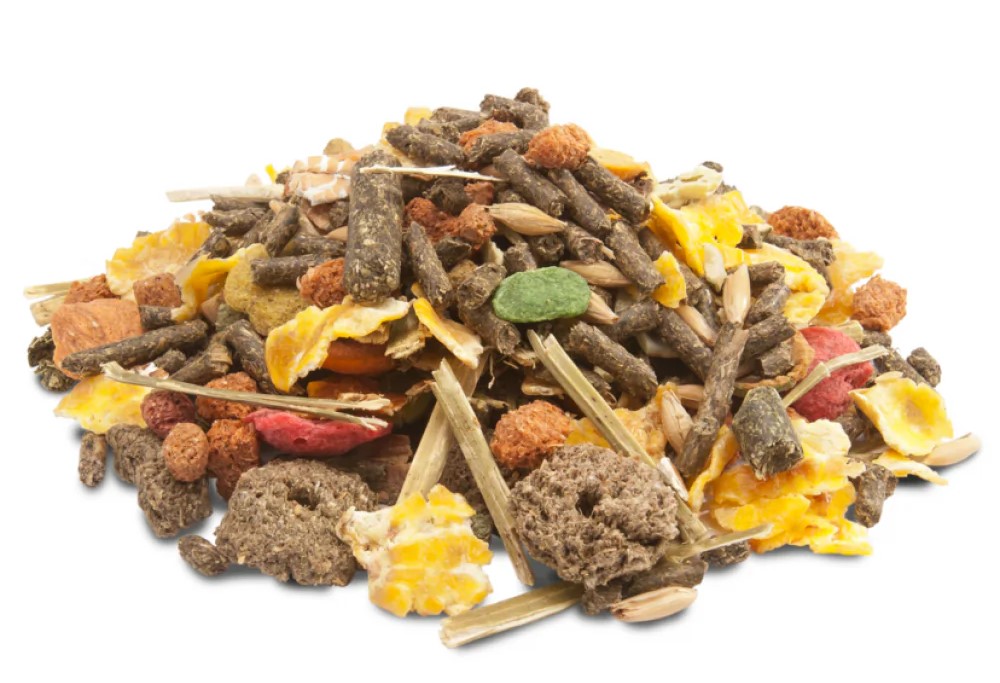
Vitamin C
Vitamin C does not need to be added to the food as long as the guinea pig gets fresh vegetables and fruit every day. If for any reason you are unable to give your guinea pig vegetables or fruit within one or two days, you can add vitamin C to the water. We add dissolvable 1000mg vitamin C tablets to the water bottle every day when we are unable to provide fresh vegetables or fruit to the guinea pig. This vitamin is difficult to overdose on, as any excess will be eliminated from the body.
Supplying vitamin C to a guinea pig is very important when the animal is sick or stressed for any reason. Consult your veterinarian.
How to change the guinea pigs' food?
It is vitally important not to change guinea pigs' food suddenly. Feeding changes should be made over a period of at least 2 weeks. This is the time your guinea pig needs to adapt its digestive system to the change in feeding.
It is recommended that guinea pigs mix the new dry food in the same bowl as the original food, in a 1:3 ratio (1 part new dry food to 3 parts original food). Feed this way over the next 3-4 days until you are sure your guinea pig has consumed all of the food. Watch carefully for possible signs of loss of appetite, abnormal unformed droppings, bloated abdomen and any changes in behaviour that may indicate that the guinea pig is not adapting well to the change in food. If your guinea pig is fine, increase the amount of new dry food and decrease the amount of the original original food. Feed again for 3-4 days and observe behavioral changes as before. If all is well, increase the ratio to 3:1 (3 parts new feed to 1 part flood diet) for another 3-4 days, and finally increase the ratio to 100% of the new dry diet.
Herding guinea pigs outdoors
Guinea pigs need to be accustomed to grazing outdoors gradually (e.g. 2 hours a day). Guinea pigs should never graze on cool, damp grass. Wait until the morning dew has dried and the grass has been warmed by the sun. An inverted box with guinea pig-sized vents will provide reliable shelter in high winds or direct sun. Guinea pigs must never be grazed on chemically treated grass. At the same time, it must not consume grass cut with a lawn mower.
Consult your veterinarian or an experienced breeder with any questions or concerns about guinea pig breeding.
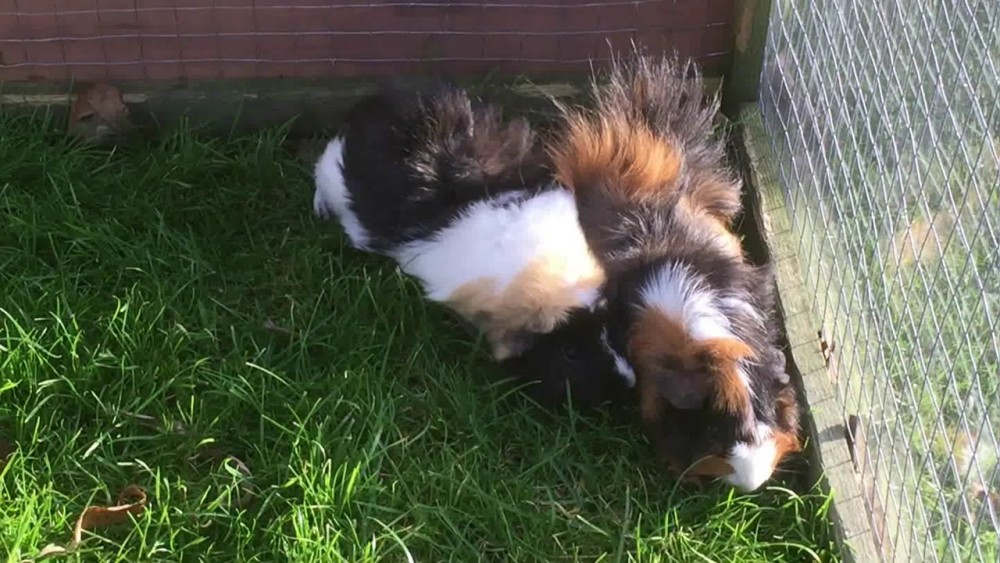
Warning: This article is for information only and does not replace professional consultation or examination of the animal by a veterinarian. If you have any doubts about the health of your pet, contact your veterinarian immediately.
19.05.2025

